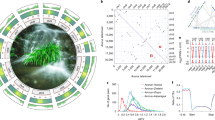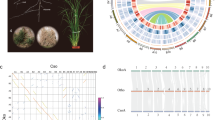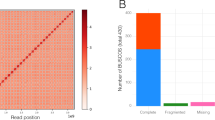Abstract
We describe here the reconstruction of the genome of the most recent common ancestor (MRCA) of modern monocots and eudicots, accounting for 95% of extant angiosperms, with its potential repertoire of 22,899 ancestral genes conserved in present-day crops. The MRCA provides a starting point for deciphering the reticulated evolutionary plasticity between species (rapidly versus slowly evolving lineages), subgenomes (pre- versus post-duplication blocks), genomic compartments (stable versus labile loci), genes (ancestral versus species-specific genes) and functions (gained versus lost ontologies), the key mutational forces driving the success of polyploidy in crops. The estimation of the timing of angiosperm evolution, based on MRCA genes, suggested that this group emerged 214 million years ago during the late Triassic era, before the oldest recorded fossil. Finally, the MRCA constitutes a unique resource for scientists to dissect major agronomic traits in translational genomics studies extending from model species to crops.
This is a preview of subscription content, access via your institution
Access options
Access Nature and 54 other Nature Portfolio journals
Get Nature+, our best-value online-access subscription
$29.99 / 30 days
cancel any time
Subscribe to this journal
Receive 12 print issues and online access
$209.00 per year
only $17.42 per issue
Buy this article
- Purchase on SpringerLink
- Instant access to full article PDF
Prices may be subject to local taxes which are calculated during checkout


Similar content being viewed by others
References
Bell, C.D., Soltis, D.E. & Soltis, P.S. The age and diversification of the angiosperms re-revisited. Am. J. Bot. 97, 1296–1303 (2010).
Magallón, S. Using fossils to break long branches in molecular dating: a comparison of relaxed clocks applied to the origin of angiosperms. Syst. Biol. 59, 384–399 (2010).
Friis, E.M., Pedersen, R. & Crane, P.R. Cretaceous angiosperm flowers: innovation and evolution in plant reproduction. Palaeogeogr. Palaeocl. Palaeoeco. 232, 251–293 (2006).
Friis, E.M., Pedersen, K.R. & Crane, P.R. Diversity in obscurity: fossil flowers and the early history of angiosperms. Phil. Trans. R. Soc. Lond. B 365, 369–382 (2010).
Soltis, D.E., Bell, C.D., Kim, S. & Soltis, P.S. Origin and early evolution of angiosperms. Ann. NY Acad. Sci. 1133, 3–25 (2008).
Doyle, J.A. Molecular and fossil evidence on the origin of angiosperms. Annu. Rev. Earth Planet. Sci. 40, 301–326 (2012).
Darwin, C. On the Origin of Species by Means of Natural Selection, or the Preservation of Favoured Races in the Struggle for Life (John Murray, 1859).
Salse, J. Ancestors of modern plant crops. Curr. Opin. Plant Biol. 30, 134–142 (2016).
International Rice Genome Sequencing Project. The map-based sequence of the rice genome. Nature 436, 793–800 (2005).
International Brachypodium Initiative. Genome sequencing and analysis of the model grass Brachypodium distachyon. Nature 463, 763–768 (2010).
Paterson, A.H. et al. The Sorghum bicolor genome and the diversification of grasses. Nature 457, 551–556 (2009).
Ming, R. et al. The pineapple genome and the evolution of CAM photosynthesis. Nat. Genet. 47, 1435–1442 (2015).
Singh, R. et al. Oil palm genome sequence reveals divergence of interfertile species in Old and New Worlds. Nature 500, 335–339 (2013).
Jaillon, O. et al. The grapevine genome sequence suggests ancestral hexaploidization in major angiosperm phyla. Nature 449, 463–467 (2007).
Argout, X. et al. The genome of Theobroma cacao. Nat. Genet. 43, 101–108 (2011).
International Peach Genome Initiative. The high-quality draft genome of peach (Prunus persica) identifies unique patterns of genetic diversity, domestication and genome evolution. Nat. Genet. 45, 487–494 (2013).
Jiao, Y. et al. Ancestral polyploidy in seed plants and angiosperms. Nature 473, 97–100 (2011).
Paterson, A.H., Bowers, J.E. & Chapman, B.A. Ancient polyploidization predating divergence of the cereals, and its consequences for comparative genomics. Proc. Natl. Acad. Sci. USA 101, 9903–9908 (2004).
Salse, J. et al. Identification and characterization of shared duplications between rice and wheat provide new insight into grass genome evolution. Plant Cell 20, 11–24 (2008).
Tang, H., Bowers, J.E., Wang, X. & Paterson, A.H. Angiosperm genome comparisons reveal early polyploidy in the monocot lineage. Proc. Natl. Acad. Sci. USA 107, 472–477 (2010).
D'Hont, A. et al. The banana (Musa acuminata) genome and the evolution of monocotyledonous plants. Nature 488, 213–217 (2012).
Jiao, Y., Li, J., Tang, H. & Paterson, A.H. Integrated syntenic and phylogenomic analyses reveal an ancient genome duplication in monocots. Plant Cell 26, 2792–2802 (2014).
Amborella Genome Project. The Amborella genome and the evolution of flowering plants. Science 342, 1241089 (2013).
Murat, F. et al. Karyotype and gene order evolution from reconstructed extinct ancestors highlight contrasts in genome plasticity of modern rosid crops. Genome Biol. Evol. 7, 735–749 (2015).
Murat, F. et al. Shared subgenome dominance following polyploidization explains grass genome evolutionary plasticity from a seven protochromosome ancestor with 16K protogenes. Genome Biol. Evol. 6, 12–33 (2014).
Banks, J.A. et al. The Selaginella genome identifies genetic changes associated with the evolution of vascular plants. Science 332, 960–963 (2011).
Murat, F. et al. Ancestral grass karyotype reconstruction unravels new mechanisms of genome shuffling as a source of plant evolution. Genome Res. 20, 1545–1557 (2010).
Freeling, M. Bias in plant gene content following different sorts of duplication: tandem, whole-genome, segmental, or by transposition. Annu. Rev. Plant Biol. 60, 433–453 (2009).
Schnable, J.C., Springer, N.M. & Freeling, M. Differentiation of the maize subgenomes by genome dominance and both ancient and ongoing gene loss. Proc. Natl. Acad. Sci. USA 108, 4069–4074 (2011).
Woodhouse, M.R. et al. Origin, inheritance, and gene regulatory consequences of genome dominance in polyploids. Proc. Natl. Acad. Sci. USA 111, 5283–5288 (2014).
Cheng, F. et al. Biased gene fractionation and dominant gene expression among the subgenomes of Brassica rapa. PLoS One 7, e36442 (2012).
Murat, F. et al. Understanding Brassicaceae evolution through ancestral genome reconstruction. Genome Biol. 10, 262 (2015).
Thomas, B.C., Pedersen, B. & Freeling, M. Following tetraploidy in an Arabidopsis ancestor, genes were removed preferentially from one homeolog leaving clusters enriched in dose-sensitive genes. Genome Res. 16, 934–946 (2006).
Pont, C. et al. Wheat syntenome unveils new evidences of contrasted evolutionary plasticity between paleo- and neoduplicated subgenomes. Plant J. 76, 1030–1044 (2013).
Renny-Byfield, S., Gong, L., Gallagher, J.P. & Wendel, J.F. Persistence of subgenomes in paleopolyploid cotton after 60 my of evolution. Mol. Biol. Evol. 32, 1063–1071 (2015).
Paterson, A.H. et al. Repeated polyploidization of Gossypium genomes and the evolution of spinnable cotton fibres. Nature 492, 423–427 (2012).
Schnable, P.S. et al. The B73 maize genome: complexity, diversity, and dynamics. Science 326, 1112–1115 (2009).
Arabidopsis Genome Initiative. Analysis of the genome sequence of the flowering plant Arabidopsis thaliana. Nature 408, 796–815 (2000).
Prasad, V., Strömberg, C.A., Alimohammadian, H. & Sahni, A. Dinosaur coprolites and the early evolution of grasses and grazers. Science 310, 1177–1180 (2005).
Drinnan, A.N., Crane, P.R. & Hoot, S.B. Patterns of floral evolution in the early diversification of non-magnoliid dicotyledons (eudicots). Plant Syst. Evol. 8, 93–122 (1994).
Hochuli, P.A. & Feist-Burkhardt, S. Angiosperm-like pollen and Afropollis from the Middle Triassic (Anisian) of the Germanic Basin (Northern Switzerland). Front. Plant Sci. 4, 344 (2013).
Hedges, S.B., Marin, J., Suleski, M., Paymer, M. & Kumar, S. Tree of life reveals clock-like speciation and diversification. Mol. Biol. Evol. 32, 835–845 (2015).
Crane, P.R., Herendeen, P. & Friis, E.M. Fossils and plant phylogeny. Am. J. Bot. 91, 1683–1699 (2004).
Zeng, L. et al. Resolution of deep angiosperm phylogeny using conserved nuclear genes and estimates of early divergence times. Nat. Commun. 5, 4956 (2014).
Smith, S.A., Beaulieu, J.M. & Donoghue, M.J. An uncorrelated relaxed-clock analysis suggests an earlier origin for flowering plants. Proc. Natl. Acad. Sci. USA 107, 5897–5902 (2010).
Magallón, S.A. & Sanderson, M.J. Angiosperm divergence times: the effect of genes, codon positions, and time constraints. Evolution 59, 1653–1670 (2005).
Labandeira, C.C. & Eble, G.J. in Gondwana Alive: Biodiversity and the Evolving Terrestrial Biosphere (eds. John, A., de Wit, M. & Thackeray, F.) (Witwatersrand University Press, 2000).
Strömberg, C.A.E. Evolution of grasses and grassland ecosystems. Annu. Rev. Earth Planet. Sci. 39, 517–544 (2011).
Šmarda, P. et al. Ecological and evolutionary significance of genomic GC content diversity in monocots. Proc. Natl. Acad. Sci. USA 111, E4096–E4102 (2014).
Vanneste, K., Maere, S. & Van de Peer, Y. Tangled up in two: a burst of genome duplications at the end of the Cretaceous and the consequences for plant evolution. Phil. Trans. R. Soc. Lond. B 369, 1648 (2014).
Moghe, G.D. & Shiu, S.H. The causes and molecular consequences of polyploidy in flowering plants. Ann. NY Acad. Sci. 1320, 16–34 (2014).
Ohno, S. Evolution by Gene Duplication (Springer, 1970).
Scannell, D.R., Byrne, K.P., Gordon, J.L., Wong, S. & Wolfe, K.H. Multiple rounds of speciation associated with reciprocal gene loss in polyploid yeasts. Nature 440, 341–345 (2006).
Aury, J.M. et al. Global trends of whole-genome duplications revealed by the ciliate Paramecium tetraurelia. Nature 444, 171–178 (2006).
Cañestro, C. in Polyploidy and Genome Evolution (eds. Soltis, M.S. & Soltis, D.E.) 309–339 (Springer, 2012).
Kellis, M., Birren, B.W. & Lander, E.S. Proof and evolutionary analysis of ancient genome duplication in the yeast Saccharomyces cerevisiae. Nature 428, 617–624 (2004).
Renny-Byfield, S. & Wendel, J.F. Doubling down on genomes: polyploidy and crop plants. Am. J. Bot. 101, 1711–1725 (2014).
Pont, C. & Salse, J. Wheat paleohistory created asymmetrical genomic evolution. Curr. Opin. Plant Biol. 6, 29–37 (2017).
Salse, J. in Advances in Genomics of Plant Genetic Resources 131–172 (Springer Verlag, 2013).
Li, L., Stoeckert, C.J. Jr. & Roos, D.S. OrthoMCL: identification of ortholog groups for eukaryotic genomes. Genome Res. 13, 2178–2189 (2003).
Salse, J., Abrouk, M., Murat, F., Quraishi, U.M. & Feuillet, C. Improved criteria and comparative genomics tool provide new insights into grass paleogenomics. Brief. Bioinform. 10, 619–630 (2009).
Pham, S.K. & Pevzner, P.A. DRIMM-Synteny: decomposing genomes into evolutionary conserved segments. Bioinformatics 26, 2509–2516 (2010).
Lin, C.H., Zhao, H., Lowcay, S.H., Shahab, A. & Bourque, G. webMGR: an online tool for the multiple genome rearrangement problem. Bioinformatics 26, 408–410 (2010).
Bouckaert, R. et al. BEAST 2: a software platform for Bayesian evolutionary analysis. PLoS Comput. Biol. 10, e1003537 (2014).
Thompson, J.D., Higgins, D.G. & Gibson, T.J. CLUSTAL W: improving the sensitivity of progressive multiple sequence alignment through sequence weighting, position-specific gap penalties and weight matrix choice. Nucleic Acids Res. 22, 4673–4680 (1994).
Lanfear, R., Calcott, B., Ho, S.Y. & Guindon, S. Partitionfinder: combined selection of partitioning schemes and substitution models for phylogenetic analyses. Mol. Biol. Evol. 29, 1695–1701 (2012).
Drummond, A.J., Suchard, M.A., Xie, D. & Rambaut, A. Bayesian phylogenetics with BEAUti and the BEAST 1.7. Mol. Biol. Evol. 29, 1969–1973 (2012).
Bouckaert, R.R. DensiTree: making sense of sets of phylogenetic trees. Bioinformatics 26, 1372–1373 (2010).
Maere, S., Heymans, K. & Kuiper, M. BiNGO: a Cytoscape plugin to assess overrepresentation of gene ontology categories in biological networks. Bioinformatics 21, 3448–3449 (2005).
Acknowledgements
The authors would like to thank C. Lanaud (CIRAD, France), C. Huneau (INRA, France) and C. Scutt (ENS, France) for assistance with obtaining the plant photos used in the illustrations. This work was supported by a grant from the Agence Nationale de la Recherche (ANR Blanc-PAGE, ref: ANR-2011-BSV6-00801) and the 'Région Auvergne, Allocation de Recherche Territoire, Agriculture, Alimentation, Nutrition et Santé Humaine' (contract 23000720).
Author information
Authors and Affiliations
Contributions
F.M., A.A., C.P., C.K. and J.S. performed the analysis and wrote the manuscript. J.S. coordinated the scientific project.
Corresponding author
Ethics declarations
Competing interests
The authors declare no competing financial interests.
Supplementary information
Supplementary Text and Figures
Supplementary Figures 1–13 and Supplementary Table 5 (PDF 3637 kb)
Supplementary Table 1
AGK gene repertoire. (XLSX 682 kb)
Supplementary Table 2
AEK gene repertoire. (XLSX 442 kb)
Supplementary Table 3
AMK gene repertoire. (XLS 1014 kb)
Supplementary Table 4
MRCA gene repertoire. (XLS 358 kb)
Rights and permissions
About this article
Cite this article
Murat, F., Armero, A., Pont, C. et al. Reconstructing the genome of the most recent common ancestor of flowering plants. Nat Genet 49, 490–496 (2017). https://doi.org/10.1038/ng.3813
Received:
Accepted:
Published:
Issue Date:
DOI: https://doi.org/10.1038/ng.3813
This article is cited by
-
Comparative analyses suggest a link between mRNA splicing, stability, and RNA covalent modifications in flowering plants
BMC Plant Biology (2024)
-
Haplotype-resolved genome assembly provides insights into evolutionary history of the Actinidia arguta tetraploid
Molecular Horticulture (2024)
-
Karyotype and LTR-RTs analysis provide insights into oak genomic evolution
BMC Genomics (2024)
-
Pan-genome and phylogenomic analyses highlight Hevea species delineation and rubber trait evolution
Nature Communications (2024)
-
Genomic evidence for rediploidization and adaptive evolution following the whole-genome triplication
Nature Communications (2024)




